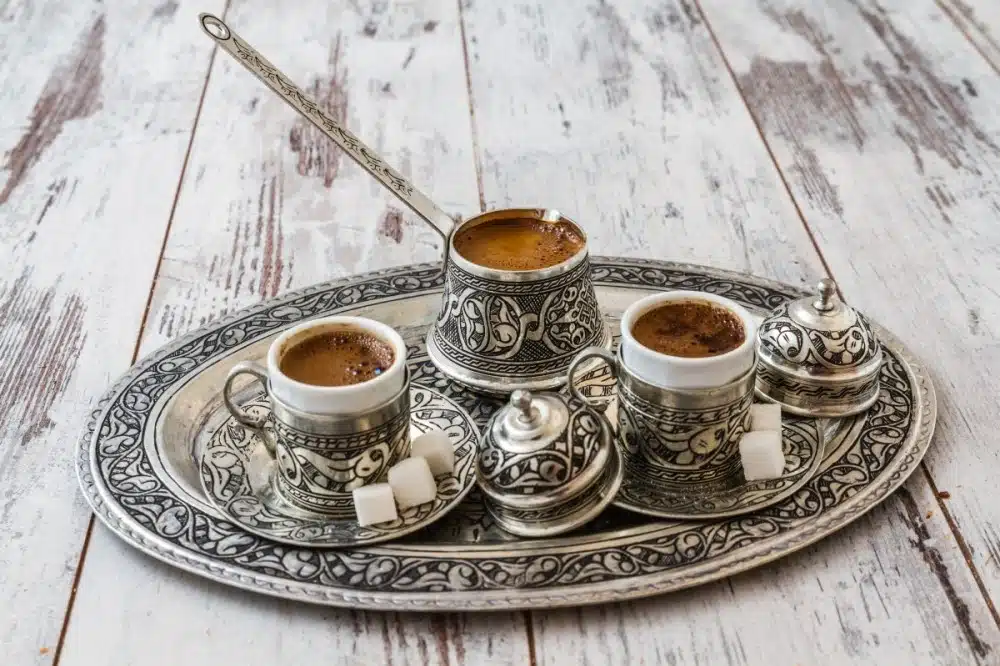Turkish coffee presentation is not just about serving a beverage; it embodies a rich tradition steeped in history and cultural significance. Each cup tells a story, inviting friends and family to gather and enjoy the moment together. As we delve into the enchanting world of Turkish coffee, we’ll explore essential ingredients, traditional brewing methods, and the importance of the coffee pot, or cezve. This delightful ritual not only tantalizes the taste buds but also creates a warm atmosphere that elevates any occasion. Join us as we uncover the artful nuances that make Turkish coffee a cherished experience.
The Art of Turkish Coffee Presentation
Turkish coffee is not just a beverage; it’s an experience that delights the senses and embodies tradition. The turkish coffee presentation plays a crucial role in this ritual, making it a feast for the eyes as well as the palate. Here are some key elements that contribute to this exquisite art:
- Serving Vessels: Traditionally, Turkish coffee is served in small, intricately designed cups called “fincan.” These delicate vessels enhance the overall aesthetic and make the experience special.
- Accompaniments: A plate of traditional sweets, like Turkish delight or dark chocolate, often accompanies the coffee. These treats complement the robust flavor and add a charming touch to the presentation.
- Serving Technique: Pouring the coffee slowly, allowing it to settle, showcases both the rich foam (or “kaimak”) and the deep, dark liquid. This technique emphasizes the coffee’s luxurious texture, elevating the turkish coffee presentation.
- Garnishing: Adding a sprinkle of ground cardamom or cinnamon not only enhances the flavor but also adds an aromatic element that captivates coffee lovers.
- Environment: A beautifully set table with elegant napkins and attention to detail captures the essence of Turkish hospitality. Soft lighting and a comfortable atmosphere make the shared experience even more memorable.
In summary, the turkish coffee presentation transforms a simple ritual into a cultural celebration, inviting friends and family to savor every moment.

History and Cultural Significance
Turkish coffee presentation is steeped in a rich history that spans centuries. Its origins trace back to the 15th century in Yemen and spread across the Ottoman Empire, ultimately resonating with cultures around the globe. Here are some fascinating points regarding its history and cultural significance:
- Cultural Heritage: In 2013, UNESCO recognized Turkish coffee as an Intangible Cultural Heritage of Humanity. This acknowledgment highlights not only the brewing technique but also the rituals and traditions associated with it.
- Social Interaction: Coffee houses, known as “kahvehane,” emerged as social hubs in the Ottoman era. They served as meeting places for political discussions, poetry readings, and music performances, establishing coffee as a pivotal element in daily social life.
- Festive Occasions: Turkish coffee plays a significant role in various celebrations and rituals. From marriage ceremonies, where the bride prepares coffee for the groom’s family, to festive gatherings, its presence symbolizes hospitality and community.
- Health and Wellness: In the past, coffee was believed to have medicinal properties, often consumed for its stimulating effects and health benefits.
The art of Turkish coffee presentation extends beyond just serving a cup; it embodies an entire culture and a shared experience, creating moments that resonate through generations. In this way, Turkish coffee transcends mere consumption and becomes a cherished ritual that fosters connection and togetherness.
Essential Ingredients for Turkish Coffee
When it comes to Turkish coffee presentation, the right ingredients play a crucial role in creating that rich, aromatic experience that this beverage is renowned for. Here’s what you need:
- Finely Ground Coffee: The heart of Turkish coffee lies in its beans. Use high-quality, Arabica coffee beans and grind them to a fine powder. A typical ratio is 1-2 teaspoons of coffee per cup.
- Water: Use cold, fresh water, as this profoundly affects the final taste. Measurements typically involve one cup (about 240ml) per serving.
- Sugar (Optional): Depending on your preference, sugar can be added to enhance the sweetness. It’s customary to ask how sweet a person would like their coffee. Here’s a quick guide:
- No Sugar: “Sade”
- A Little Sugar: “Az Şekerli”
- Medium Sugar: “Orta”
- Sweet: “Şekerli”
- Cardamom (Optional): Some people add a touch of ground cardamom for a unique twist, enhancing the flavor profile and adding depth to the Turkish coffee presentation.
Combining these ingredients in a cezve (Turkish coffee pot) allows the coffee to brew to perfection, ensuring a robust and delightful flavor. Paying attention to these essentials not only elevates the taste but also enhances the overall Turkish coffee presentation, making it a moment to savor.
Traditional Brewing Methods
The journey to an exceptional turkish coffee presentation begins with mastering traditional brewing methods. Each technique highlights the unique flavors and aromas of the coffee, elevating the entire experience. Here are some classic methods to consider:
- Cezve Method:
- Involves a small, long-handled pot (cezve).
- Combine finely ground coffee and water, usually in a 1:1 ratio, in the cezve.
- Place over low heat until it begins to foam, then remove before it boils. Repeat this process 2-3 times for a richer flavor.
- Sand Method:
- Utilizes heated sand for a uniform temperature.
- The cezve is placed directly into hot sand, allowing for precise control over the brewing temperature.
- Pottery Method:
- Involves using a clay pot to enhance the aroma and flavor.
- The ceramic retains heat well, providing an even brew.
| Brewing Method | Flavor Profile | Equipment Required | Time Required |
|---|---|---|---|
| Cezve Method | Rich and aromatic | Cezve | 5-10 minutes |
| Sand Method | Smooth and balanced | Cezve, Sand | 10-15 minutes |
| Pottery Method | Earthy and nuanced | Clay Pot | 5-10 minutes |
In conclusion, understanding these traditional brewing methods is key to achieving an authentic turkish coffee presentation. Each method has its distinct characteristics, which enhance the overall coffee-drinking experience. Enjoy experimenting with these techniques to find your favorite!
The Importance of the Coffee Pot (Cezve)
The cezve, a small, long-handled pot, serves as the heart of Turkish coffee presentation. This traditional vessel not only holds significant cultural value but also plays a crucial role in brewing the perfect cup of coffee.
Key Features of the Cezve:
- Material: Typically made of copper, brass, or stainless steel, the cezve retains heat well, allowing for an even extraction of flavors.
- Shape: The unique design, with a narrow neck and wide base, helps create a rich foam—the hallmark of authentic Turkish coffee.
- Size: Cezves come in various sizes, accommodating from a single serving to multiple cups, making it versatile for any gathering.
Brewing Benefits:
- Flavor Development: The cezve allows for gentle simmering, which brings out intricate flavor notes while preventing bitterness.
- Foam Creation: The design facilitates the formation of krem (foam), an essential aspect of Turkish coffee presentation that enhances both taste and aesthetic appeal.
Comparison of Coffee Pots:
| Aspect | Cezve | Regular Coffee Pot |
|---|---|---|
| Material | Copper/Brass/Stainless | Glass/Plastic |
| Heat Retention | Excellent | Moderate |
| Foam Quality | High | Low |
In summary, the cezve is not just a tool but an integral component of the Turkish coffee presentation. Its proper use enhances both the flavor and the visual allure, creating a delightful experience that respects the traditions of this beloved beverage. Enjoying Turkish coffee brewed in a cezve truly captures the essence of its cultural heritage!
Serving Techniques for Turkish Coffee
Serving Turkish coffee is as significant as brewing it. The presentation elevates the entire experience, creating an inviting atmosphere. Here are some essential serving techniques that highlight the beauty of Turkish coffee presentation:
- Use Traditional Cups: Serve in small, ornate cups, preferably made of porcelain or copper. These cups allow the aroma to concentrate, enhancing the coffee’s flavors.
- Serve with a Sweet Treat: Accompany each cup with a piece of Turkish delight or a chocolate-covered treat. This pairing not only complements the coffee but also adds an element of indulgence.
- Presentation on a Tray: Use a decorative tray to present the coffee. Arrange the cups and sweets neatly, and consider adding a small glass of water. This juxtaposition demonstrates hospitality and the unique experience of Turkish coffee.
- Ceremonial Pouring: Pour the coffee slowly and carefully to create anticipation. This can turn the act of serving into a ritual, enhancing the enjoyment of the rich flavors.
- Use a Coffee Sifter: If desired, top each cup with a sprinkle of cinnamon or cardamom. This small touch invigorates the senses and brings a personal flair to the Turkish coffee presentation.
The above techniques ensure that each serving of Turkish coffee not only delights the palate but also enriches the overall experience, intertwining tradition with modern aesthetics.
Pairing Turkish Coffee with Sweets
Pairing Turkish coffee with sweets elevates the experience, bringing together rich flavors and delightful textures. The traditional ritual of enjoying Turkish coffee goes beyond just the drink; it celebrates the harmony between coffee and its complimentary treats. Here’s how to create the perfect pairing for an authentic turkish coffee presentation.
Popular Sweet Pairings:
- Baklava: The sweet, flaky layers of this pastry enhance the bitterness of Turkish coffee beautifully.
- Turkish Delight (Lokum): Its chewy texture and various flavors, such as rose and lemon, provide a delightful contrast to the coffee’s bold taste.
- Chocolate: Dark or milk chocolate can balance the strong, rich coffee and add a touch of indulgence.
- Pistachios: These nuts add a crunchy texture and a hint of saltiness, complementing the coffee’s flavor profile.
Serving Tips:
- Presentation Matters: Serve the coffee in ornate cups alongside your sweets on a decorative tray. This enhances the turkish coffee presentation.
- Temperature Balance: Serve your sweets at room temperature, so they don’t overpower the hot coffee.
- Mind the Portions: Offer small, bite-sized pieces to allow guests to savor both the coffee and sweets without overwhelming their palates.
Combining Turkish coffee with these delectable treats creates an experience that is not just about taste but also about sharing and enjoying moments with loved ones. Whether you host a gathering or enjoy a solitary cup, sweet pairings will surely enhance your turkish coffee presentation.

Creating the Perfect Coffee Setting
Crafting an inviting atmosphere for your Turkish coffee presentation elevates the experience and enhances the enjoyment of this rich beverage. It’s all about attention to detail, combining aesthetics with cultural traditions. Here are essential elements to consider:
- Choose the Right Environment: Opt for a cozy space, preferably with comfortable seating and warm lighting. This encourages conversation and connection.
- Tableware and Utensils: Use traditional cups, known as finjan, for serving. Their intricate designs add an authentic touch, while a well-crafted cezve makes a stunning centerpiece.
- Healthy Snacks: Accompany your coffee with sweet treats like Turkish delight or baklava. Arrange these delicacies on a decorative platter for a visually appealing display.
- Cultural Accents: Incorporate elements of Turkish culture, such as traditional linens or decorative coasters, which enrich the Turkish coffee presentation.
- Presentation Order: Serve your coffee alongside the sweets. This not only looks inviting but invites guests to enjoy the experience that much more.
By thoughtfully arranging these elements, you create a memorable setting that honors the deep-rooted traditions of Turkish coffee culture. Ultimately, enjoying coffee is not just about the drink itself, but the shared moments that revolve around it.
Rituals and Customs Surrounding Coffee Drinking
Turkish coffee presentation is not merely about serving a delicious brew; it’s steeped in rich traditions and customs that enhance the experience. The act of drinking coffee in Turkey carries deep cultural significance, encapsulating hospitality, friendship, and respect.
Key Rituals and Customs:
- The Greeting: Guests are welcomed with coffee as a sign of respect and hospitality. It’s a standard custom to offer coffee as soon as friends or family enter a home.
- Fortune-Telling with Grounds: After sipping the coffee, many enjoy a playful ritual of interpreting the leftover grounds. You can flip the cup upside down, allowing for conversations about destiny and future.
- Coffee and Conversation: Sharing Turkish coffee often encourages long discussions, forging deeper connections among friends and family. The slow sipping symbolizes taking time to enjoy life.
- Coffee as a Gift: When visiting someone, bringing coffee as a gift signifies thoughtfulness and connection, reinforcing social bonds.
- Special Occasions: On joyous occasions like weddings, a special coffee preparation takes place, sometimes with added spices for flavor and celebration.
In sum, the turkish coffee presentation combines taste with deeply rooted traditions, making every cup a rich blend of flavor and cultural connection.
Modern Twists on Turkish Coffee Presentation
In today’s fast-paced world, traditional practices evolve and blend with contemporary styles. Turkish coffee presentation, once bound by classic norms, now embraces modern twists that enhance the drinking experience. Here are some delightful innovations:
- Aesthetic Serveware: Moving beyond traditional cups, modern presentations often utilize elegant glass mugs, ceramic designs, or even artistic Turkish coffee sets. This fresh approach focuses on visual appeal, emphasizing the beauty of the brew.
- Flavor Infusions: Today’s coffee lovers experiment with unique flavors. Adding spices like cardamom or presenting flavored coffee alongside herbs elevates the experience, making each cup a delightful surprise for the palate.
- Creative Pairings: Modern presentations focus on serving Turkish coffee with an array of gourmet sweets—from dark chocolate truffles to artisanal pastries. These pairings enhance the flavor profile and offer a sumptuous experience.
- Themed Settings: Setting up an enchanting coffee corner with thematic decorations, soft lighting, and cultural music adds to the ambiance. This approach turns every cup of Turkish coffee into a memorable event.
By integrating these modern twists on Turkish coffee presentation, enthusiasts can not only honor tradition but also delight in new, flavorful experiences. The fusion of old and new invigorates the cultural significance of this beloved beverage, making it a joy to share with friends and family.

Conclusion: The Joy of Sharing Turkish Coffee
In conclusion, the experience of Turkish coffee presentation transcends mere consumption; it transforms into a delightful ritual that fosters connection and camaraderie. The artful process of brewing and serving Turkish coffee invites conversations, stories, and laughter. Here are a few points that capture the essence of this communal experience:
- Social Bonding: Sharing a cup of Turkish coffee serves as a bridge between cultures and generations, creating cherished memories with loved ones.
- Cultural Richness: The tradition of Turkish coffee embodies centuries of history, bringing together diverse flavors and practices.
- Aesthetic Appeal: The unique and beautiful Turkish coffee presentation—complete with ornate cups and joyful gatherings—adds a visual incentive to the experience.
When you sit together with family or friends, savoring the rich, aromatic taste of Turkish coffee, you not only enjoy a beverage but also participate in a time-honored tradition. Ultimately, the joy of sharing Turkish coffee lies in the collective moments created, enhancing every sip with laughter and warmth. So, next time you prepare for a turkish coffee presentation, remember to embrace the spirit of togetherness that it inspires. Cheers to the communal delight of sharing this exquisite coffee!
Frequently Asked Questions
What makes Turkish coffee unique compared to other types of coffee?
Turkish coffee is unique because of its distinct preparation method that involves finely ground coffee beans, water, and often sugar. It is brewed in a special pot called a cezve, allowing the coffee to slowly boil and form a frothy layer on top, known as ‘kaimak.’ This method highlights the rich flavors and aromas of the coffee, providing a full-bodied taste that is different from other brewing techniques.
How should I serve Turkish coffee for the best experience?
Serving Turkish coffee is an art form in itself. It is traditionally served in small cups with a glass of water on the side to cleanse the palate. Accompanying it with a sweet treat, such as Turkish delight or chocolate, enhances the experience. It’s also customary to pour the coffee carefully so that the grounds remain in the pot, ensuring a clean presentation and taste.
Can I make Turkish coffee at home, and what equipment do I need?
Absolutely! Making Turkish coffee at home is quite simple and requires just a few essential items. You will need a cezve, finely ground Turkish coffee, and optionally, sugar. Simply combine water and coffee in the cezve, heat it slowly on low to medium flame until it bubbles and froths. Pour carefully into cups while leaving the grounds behind in the pot. Enjoying homemade Turkish coffee can be a delightful ritual.
Is there a specific coffee bean type recommended for Turkish coffee?
For the best Turkish coffee, it is recommended to use Arabica coffee beans due to their smooth flavor and aromatic qualities. The coffee should be ground to a very fine powder, almost like flour, to ensure that it blends well with water and creates the perfect texture and flavor. Feel free to experiment with different roasts to discover your personal preference.
What cultural significance does Turkish coffee hold in Turkey?
Turkish coffee holds profound cultural significance in Turkey as it symbolizes hospitality, friendship, and socialization. Serving coffee to guests is a traditional gesture of welcoming. Additionally, it has been recognized by UNESCO as an intangible cultural heritage, highlighting its importance in Turkish culture. Rituals surrounding coffee preparation and enjoyment embody a rich history that connects people and traditions.


